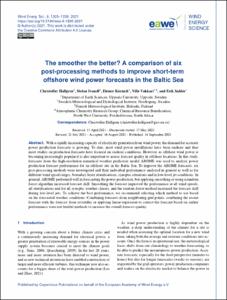| dc.contributor.author | Hallgren, Christoffer | |
| dc.contributor.author | Ivanell, Stefan | |
| dc.contributor.author | Körnich, Heiner | |
| dc.contributor.author | Vakkari, Ville | |
| dc.contributor.author | Sahlée, Erik | |
| dc.coverage.spatial | Baltic Sea | en_US |
| dc.date.accessioned | 2022-03-23T21:40:00Z | |
| dc.date.available | 2022-03-23T21:40:00Z | |
| dc.date.issued | 2021 | |
| dc.identifier.citation | Hallgren, C., Ivanell, S., Körnich, H., Vakkari, V., and Sahlée, E. (2021) The smoother the better? A comparison of six post-processing methods to improve short-term offshore wind power forecasts in the Baltic Sea, Wind Energy Science, 6, pp.1205–1226, DOI: https://doi.org/10.5194/wes-6-1205-2021 | en_US |
| dc.identifier.uri | https://repository.oceanbestpractices.org/handle/11329/1893 | |
| dc.description.abstract | With a rapidly increasing capacity of electricity generation from wind power, the demand for accurate power production forecasts is growing. To date, most wind power installations have been onshore and thus most studies on production forecasts have focused on onshore conditions. However, as offshore wind power is becoming increasingly popular it is also important to assess forecast quality in offshore locations. In this study, forecasts from the high-resolution numerical weather prediction model AROME was used to analyze power production forecast performance for an offshore site in the Baltic Sea. To improve the AROME forecasts, six post-processing methods were investigated and their individual performance analyzed in general as well as for different wind speed ranges, boundary layer stratifications, synoptic situations and in low-level jet conditions. In general, AROME performed well in forecasting the power production, but applying smoothing or using a random forest algorithm increased forecast skill. Smoothing the forecast improved the performance at all wind speeds, all stratifications and for all synoptic weather classes, and the random forest method increased the forecast skill during low-level jets. To achieve the best performance, we recommend selecting which method to use based on the forecasted weather conditions. Combining forecasts from neighboring grid points, combining the recent forecast with the forecast from yesterday or applying linear regression to correct the forecast based on earlier performance were not fruitful methods to increase the overall forecast quality. | en_US |
| dc.language.iso | en | en_US |
| dc.rights | Attribution 4.0 International | * |
| dc.rights.uri | http://creativecommons.org/licenses/by/4.0/ | * |
| dc.subject.other | Wind power production | en_US |
| dc.title | The smoother the better? A comparison of six post-processing methods to improve short-term offshore wind power forecasts in the Baltic Sea. | en_US |
| dc.type | Journal Contribution | en_US |
| dc.description.refereed | Refereed | en_US |
| dc.format.pagerange | pp.1205–1226 | en_US |
| dc.identifier.doi | https://doi.org/10.5194/wes-6-1205-2021 | |
| dc.subject.parameterDiscipline | Meteorology | en_US |
| dc.subject.dmProcesses | Data analysis | en_US |
| dc.subject.dmProcesses | Data processing | en_US |
| dc.bibliographicCitation.title | Wind Wnergy Science | en_US |
| dc.bibliographicCitation.volume | 6 | en_US |
| dc.bibliographicCitation.issue | 5 | en_US |
| dc.description.sdg | 14.a | en_US |
| dc.description.sdg | 7.1 | en_US |
| dc.description.eov | N/A | en_US |
| dc.description.methodologyType | Reports with methodological relevance | en_US |
| obps.contact.contactname | Christoffer Hallgren | |
| obps.contact.contactemail | christoffer.hallgren@geo.uu.se | |
| obps.resourceurl.publisher | https://wes.copernicus.org/articles/6/1205/2021/ | |
 Repository of community practices in Ocean Research, Applications and Data/Information Management
Repository of community practices in Ocean Research, Applications and Data/Information Management

